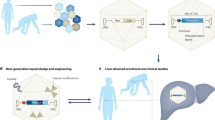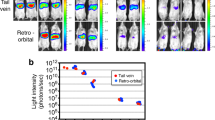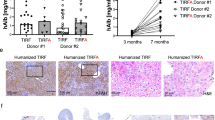Abstract
Liver transplantation is the only treatment for advanced liver cirrhosis. Therapies halting the progression of the disease are urgently needed. Administration of recombinant insulin-like growth factor-I (rIGF-I) induces hepatoprotective effects in experimental cirrhosis. Therefore, we analyzed the efficacy of a recombinant simian virus 40 vector (rSV40) encoding IGF-I (rSVIGF-I) to prevent cirrhosis progression. First, transgene expression was evaluated in mice injected with rSV40 encoding luciferase, which showed long-term hepatic expression of the transgene. Interestingly, luciferase expression increased significantly in CCl4-damaged livers and upon IGF-I administration, thus liver injury and IGF-I expression from rSVIGF-I should favor transgene expression. rSVIGF-I therapeutic efficacy was studied in rats where liver cirrhosis was induced by CCl4 inhalation during 36 weeks. At the end of the study, the hepatic levels of IGF-I and IGF-binding protein 3 were higher in rSVIGF-I-treated rats than in control cirrhotic animals. Cirrhotic rats treated with rSVIGF-I had reduced serum bilirubin, transaminases and liver fibrosis scores and increased hepatic expression of hepatocyte growth factor and STAT3α as compared to cirrhotic animals. Furthermore, cirrhotic animals showed testis atrophy and altered spermatogenesis, whereas testicular size and histology were normal in cirrhotic rats that received rSVIGF-I. Therefore, rSV40-mediated sustained expression of IGF-I in the liver slowed cirrhosis progression.
This is a preview of subscription content, access via your institution
Access options
Subscribe to this journal
Receive 12 print issues and online access
$259.00 per year
only $21.58 per issue
Buy this article
- Purchase on Springer Link
- Instant access to full article PDF
Prices may be subject to local taxes which are calculated during checkout






Similar content being viewed by others
References
Bataller R, Brenner DA . Liver fibrosis. J Clin Invest 2005; 115: 209–218.
Friedman SL . Molecular regulation of hepatic fibrosis, an integrated cellular response to tissue injury. J Biol Chem 2000; 275: 2247–2250.
Friedman SL . Liver fibrosis – from bench to bedside. J Hepatol 2003; 38: S38–S53.
De Palo EF, Bassanello M, Lancerin F, Spinella P, Gatti R, D'Amico D et al. GH/IGF system, cirrhosis and liver transplantation. Clin Chim Acta 2001; 310: 31–37.
Adamo M, Lowe Jr WL, LeRoith D, Roberts CT . Insulin-like growth factor I messenger ribonucleic acids with alternative 5′-untranslated regions are differentially expressed during development of the rat. Endocrinology 1989; 124: 2737–2744.
Yakar S, Liu JL, Stannard B, Butler A, Accili D, Sauer B et al. Normal growth and development in the absence of hepatic insulin-like growth factor I. Proc Natl Acad Sci USA 1999; 96: 7324–7329.
Mohan S, Baylink DJ . IGF-binding proteins are multifunctional and act via IGF-dependent and -independent mechanisms. J Endocrinol 2002; 175: 19–31.
Rajaram S, Baylink DJ, Mohan S . Insulin-like growth factor-binding proteins in serum and other biological fluids: regulation and functions. Endocr Rev 1997; 18: 801–831.
Castilla-Cortazar I, Garcia M, Quiroga J, Diez N, Diez-Caballero F, Calvo A et al. Insulin-like growth factor-I reverts testicular atrophy in rats with advanced cirrhosis. Hepatology 2000; 31: 592–600.
Castilla-Cortazar I, Garcia M, Muguerza B, Quiroga J, Perez R, Santidrian S et al. Hepatoprotective effects of insulin-like growth factor I in rats with carbon tetrachloride-induced cirrhosis. Gastroenterology 1997; 113: 1682–1691.
Muguerza B, Castilla-Cortazar I, Garcia M, Quiroga J, Santidrian S, Prieto J . Antifibrogenic effect in vivo of low doses of insulin-like growth factor-I in cirrhotic rats. Biochim Biophys Acta 2001; 1536: 185–195.
Conchillo M, de Knegt RJ, Payeras M, Quiroga J, Sangro B, Herrero JI et al. Insulin-like growth factor I (IGF-I) replacement therapy increases albumin concentration in liver cirrhosis: results of a pilot randomized controlled clinical trial. J Hepatol 2005; 43: 630–636.
Arad U, Zeira E, El-Latif MA, Mukherjee S, Mitchell L, Pappo O et al. Liver-targeted gene therapy by SV40-based vectors using the hydrodynamic injection method. Hum Gene Ther 2005; 16: 361–371.
Strayer D, Branco F, Zern MA, Yam P, Calarota SA, Nichols CN et al. Durability of transgene expression and vector integration: recombinant SV40-derived gene therapy vectors. Mol Ther 2002; 6: 227–237.
Vera M, Fortes P . Simian virus-40 as a gene therapy vector. DNA Cell Biol 2004; 23: 271–282.
Duan YY, Wu J, Zhu JL, Liu SL, Ozaki I, Strayer DS et al. Gene therapy for human alpha1-antitrypsin deficiency in an animal model using SV40-derived vectors. Gastroenterology 2004; 127: 1222–1232.
Sauter BV, Parashar B, Chowdhury NR, Kadakol A, Ilan Y, Singh H et al. A replication-deficient rSV40 mediates liver-directed gene transfer and a long-term amelioration of jaundice in gunn rats. Gastroenterology 2000; 119: 1348–1357.
Sanz S, Pucilowska JB, Liu S, Rodriguez-Ortigosa CM, Lund PK, Brenner DA et al. Expression of insulin-like growth factor I by activated hepatic stellate cells reduces fibrogenesis and enhances regeneration after liver injury. Gut 2005; 54: 134–141.
Poli G . Pathogenesis of liver fibrosis: role of oxidative stress. Mol Aspects Med 2000; 21: 49–98.
Matsuda Y, Matsumoto K, Yamada A, Ichida T, Asakura H, Komoriya Y et al. Preventive and therapeutic effects in rats of hepatocyte growth factor infusion on liver fibrosis/cirrhosis. Hepatology 1997; 26: 81–89.
Jacoby JJ, Kalinowski A, Liu MG, Zhang SS, Gao Q, Chai GX et al. Cardiomyocyte-restricted knockout of STAT3 results in higher sensitivity to inflammation, cardiac fibrosis, and heart failure with advanced age. Proc Natl Acad Sci USA 2003; 100: 12929–12934.
Larrea E,, Aldabe R, Molano E, Fernandez-Rodriguez CM, Ametzazurra A, Civeira MP et al. Altered expression and activation of STATs (signal transduction and activator of transcription) in HCV infection: in vivo and in vitro studies. Gut (in press).
Matsuno Y, Iwata H, Umeda Y, Takagi H, Mori Y, Kosugi A et al. Hepatocyte growth factor gene transfer into the liver via the portal vein using electroporation attenuates rat liver cirrhosis. Gene Therapy 2003; 10: 1559–1566.
Ueki T, Kaneda Y, Tsutsui H, Nakanishi K, Sawa Y, Morishita R et al. Hepatocyte growth factor gene therapy of liver cirrhosis in rats. Nat Med 1999; 5: 226–230.
Morales-Ruiz M, Cejudo-Martin P, Fernandez-Varo G, Tugues S, Ros J, Angeli P et al. Transduction of the liver with activated Akt normalizes portal pressure in cirrhotic rats. Gastroenterology 2003; 125: 522–531.
Qi Z, Atsuchi N, Ooshima A, Takeshita A, Ueno H . Blockade of type beta transforming growth factor signaling prevents liver fibrosis and dysfunction in the rat. Proc Natl Acad Sci USA 1999; 96: 2345–2349.
Ariosto F, Riggio O, Cantafora A, Colucci S, Gaudio E, Mechelli C et al. Carbon tetrachloride-induced experimental cirrhosis in the rat: a reappraisal of the model. Eur Surg Res 1989; 21: 280–286.
Wong FW, Chan WY, Lee SS . Resistance to carbon tetrachloride-induced hepatotoxicity in mice which lack CYP2E1 expression. Toxicol Appl Pharmacol 1998; 153: 109–118.
Chen GF, Ronis MJ, Ingelman-Sundberg M, Badger TM . Hormonal regulation of microsomal cytochrome P4502E1 and P450 reductase in rat liver and kidney. Xenobiotica 1999; 29: 437–451.
Chan JM, Stampfer MJ, Ma J, Gann P, Gaziano JM, Pollak M et al. Insulin-like growth factor-I (IGF-I) and IGF binding protein-3 as predictors of advanced-stage prostate cancer. J Natl Cancer Inst 2002; 94: 1099–1106.
Wu Y, Yakar S, Zhao L, Hennighausen L, LeRoith D . Circulating insulin-like growth factor-I levels regulate colon cancer growth and metastasis. Cancer Res 2002; 62: 1030–1035.
Zaitoun AM, Apelqvist G, Wikell C, Al-Mardini H, Bengtsson F, Record CO . Quantitative studies of testicular atrophy following portacaval shunt in rats. Hepatology 1998; 28: 1461–1466.
Vera M, Razquin N, Prieto J, Melero I, Fortes P, Gonzalez-Aseguinolaza G . Intratumoral injection of dendritic cells transduced by an SV40-based vector expressing interleukin-15 induces curative immunity mediated by CD8(+) T lymphocytes and NK cells. Mol Ther 2005; 12: 950–959.
Vera M, Prieto J, Strayer DS, Fortes P . Factors influencing the production of recombinant SV40 vectors. Mol Ther 2004; 10: 780–791.
Bustos M, Beraza N, Lasarte JJ, Baixeras E, Alzuguren P, Bordet T et al. Protection against liver damage by cardiotrophin-1: a hepatocyte survival factor up-regulated in the regenerating liver in rats. Gastroenterology 2003; 125: 192–201.
Mirpuri E, Garcia-Trevijano ER, Castilla-Cortazar I, Berasain C, Quiroga J, Rodriguez-Ortigosa C et al. Altered liver gene expression in CCl4-cirrhotic rats is partially normalized by insulin-like growth factor-I. Int J Biochem Cell Biol 2002; 34: 242–252.
Massoud TF, Gambhir SS . Molecular imaging in living subjects: seeing fundamental biological processes in a new light. Genes Dev 2003; 17: 545–580.
Priego T, Granado M, Ibanez de Caceres I, Martin AI, Villanua MA, Lopez-Calderon A . Endotoxin at low doses stimulates pituitary GH whereas it decreases IGF-I and IGF-binding protein-3 in rats. J Endocrinol 2003; 179: 107–117.
Chomczynski P, Sacchi N . Single-step method of RNA isolation by acid guanidinium thiocyanate–phenol–chloroform extraction. Anal Biochem 1987; 162: 156–159.
Woessner Jr JF . The determination of hydroxyproline in tissue and protein samples containing small proportions of this imino acid. Arch Biochem Biophys 1961; 93: 440–447.
Querejeta R, Varo N, Lopez B, Larman M, Artinano E, Etayo JC et al. Serum carboxy-terminal propeptide of procollagen type I is a marker of myocardial fibrosis in hypertensive heart disease. Circulation 2000; 101: 1729–1735.
Acknowledgements
We thank J Novo for providing rat IGF-I cDNA. Technical assistance by N Razquin and E Casales is thankfully acknowledged. M Wodecki help was essential in rat surgery. We also thank members of the lab for advice and Cristian Smedou and Ruben Hernandez for critical reading of the paper. This work was supported by CICYT (PM1999/0091), CICYT (SAF2003-01804), CICYT (SAF 2002-0327), FIS (01/1310 and 01/0843), Instituto Carlos III (C03/02 and PI051098), Education and Health Department of Navarra Government and through the ‘UTE project CIMA’. MV is an FPI fellow.
Author information
Authors and Affiliations
Corresponding author
Rights and permissions
About this article
Cite this article
Vera, M., Sobrevals, L., Zaratiegui, M. et al. Liver transduction with a simian virus 40 vector encoding insulin-like growth factor I reduces hepatic damage and the development of liver cirrhosis. Gene Ther 14, 203–210 (2007). https://doi.org/10.1038/sj.gt.3302858
Received:
Revised:
Accepted:
Published:
Issue Date:
DOI: https://doi.org/10.1038/sj.gt.3302858
Keywords
This article is cited by
-
Insulin-like growth factor-1 attenuates oxidative stress-induced hepatocyte premature senescence in liver fibrogenesis via regulating nuclear p53–progerin interaction
Cell Death & Disease (2019)
-
AAV vectors transduce hepatocytes in vivo as efficiently in cirrhotic as in healthy rat livers
Gene Therapy (2012)
-
Insulin-like growth factor-1 isoforms in rat hepatocytes and cholangiocytes and their involvement in protection against cholestatic injury
Laboratory Investigation (2008)
-
Simian virus 40 vectors for pulmonary gene therapy
Respiratory Research (2007)



